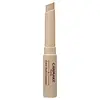What's inside
What's inside
 Key Ingredients
Key Ingredients

 Benefits
Benefits

 Concerns
Concerns

 Ingredients Side-by-side
Ingredients Side-by-side

Titanium Dioxide
Cosmetic ColorantHydrogenated Polydecene
EmollientDiphenylsiloxy Phenyl Trimethicone
Skin ConditioningTriethylhexanoin
MaskingPolyethylene
AbrasiveAlumina
AbrasiveDiisostearyl Malate
EmollientSorbitan Sesquiisostearate
EmulsifyingMica
Cosmetic ColorantAluminum Hydroxide
EmollientPhytosteryl/Octyldodecyl Lauroyl Glutamate
Skin ConditioningDimethicone
EmollientSilica
AbrasiveCopernicia Cerifera Wax
Microcrystalline Wax
Emulsion StabilisingTocopherol
AntioxidantMethicone
EmollientSodium Hyaluronate
HumectantHydrolyzed Hyaluronic Acid
HumectantTriethoxycaprylylsilane
Synthetic Fluorphlogopite
CI 77492
Cosmetic ColorantTitanium Dioxide, Hydrogenated Polydecene, Diphenylsiloxy Phenyl Trimethicone, Triethylhexanoin, Polyethylene, Alumina, Diisostearyl Malate, Sorbitan Sesquiisostearate, Mica, Aluminum Hydroxide, Phytosteryl/Octyldodecyl Lauroyl Glutamate, Dimethicone, Silica, Copernicia Cerifera Wax, Microcrystalline Wax, Tocopherol, Methicone, Sodium Hyaluronate, Hydrolyzed Hyaluronic Acid, Triethoxycaprylylsilane, Synthetic Fluorphlogopite, CI 77492
Isodecyl Neopentanoate
EmollientPropylene Glycol Dicaprylate/Dicaprate
EmollientSynthetic Wax
AbrasiveIsononyl Isononanoate
EmollientOctyldodecanol
EmollientParaffin
PerfumingCaprylic/Capric Triglyceride
MaskingSilica
AbrasiveDimethicone
EmollientPolyglyceryl-3 Diisostearate
EmulsifyingCera Microcristallina
Emulsion StabilisingLimnanthes Alba Seed Oil
Skin ConditioningStearalkonium Hectorite
Gel FormingDimethicone/Vinyl Dimethicone Crosspolymer
Skin ConditioningLecithin
EmollientAluminum Hydroxide
EmollientIsopropyl Myristate
EmollientPropylene Carbonate
SolventIsostearic Acid
CleansingEthylhexyl Palmitate
EmollientPolyglyceryl-3 Polyricinoleate
EmulsifyingPolyhydroxystearic Acid
EmulsifyingPhenoxyethanol
PreservativeIsodecyl Neopentanoate, Propylene Glycol Dicaprylate/Dicaprate, Synthetic Wax, Isononyl Isononanoate, Octyldodecanol, Paraffin, Caprylic/Capric Triglyceride, Silica, Dimethicone, Polyglyceryl-3 Diisostearate, Cera Microcristallina, Limnanthes Alba Seed Oil, Stearalkonium Hectorite, Dimethicone/Vinyl Dimethicone Crosspolymer, Lecithin, Aluminum Hydroxide, Isopropyl Myristate, Propylene Carbonate, Isostearic Acid, Ethylhexyl Palmitate, Polyglyceryl-3 Polyricinoleate, Polyhydroxystearic Acid, Phenoxyethanol
 Reviews
Reviews

Ingredients Explained
These ingredients are found in both products.
Ingredients higher up in an ingredient list are typically present in a larger amount.
Aluminum Hydroxide is a form of aluminum. It can be naturally found in nature as the mineral gibbsite. In cosmetics, Aluminum Hydroxide is used as a colorant, pH adjuster, and absorbent.
As a colorant, Aluminum Hydroxide may add opacity, or reduce the transparency. Aluminum hydroxide is contains both basic and acidic properties.
According to manufacturers, this ingredient is an emollient and humectant. This means it helps hydrate the skin.
In medicine, this ingredient is used to help relieve heartburn and help heal ulcers.
There is currently no credible scientific evidence linking aluminum hydroxide in cosmetics to increased cancer risk.
Major health organizations allow the use of aluminum hydroxide in personal care products and have not flagged it as a carcinogenic risk at typical usage levels.
Learn more about Aluminum HydroxideDimethicone is a type of synthetic silicone created from natural materials such as quartz.
What it does:
Dimethicone comes in different viscosities:
Depending on the viscosity, dimethicone has different properties.
Ingredients lists don't always show which type is used, so we recommend reaching out to the brand if you have questions about the viscosity.
This ingredient is unlikely to cause irritation because it does not get absorbed into skin. However, people with silicone allergies should be careful about using this ingredient.
Note: Dimethicone may contribute to pilling. This is because it is not oil or water soluble, so pilling may occur when layered with products. When mixed with heavy oils in a formula, the outcome is also quite greasy.
Learn more about DimethiconeSilica, also known as silicon dioxide, is a naturally occurring mineral. It is used as a fine, spherical, and porous powder in cosmetics.
Though it has exfoliant properties, the function of silica varies depending on the product.
The unique structure of silica enhances the spreadability and adds smoothness, making it a great texture enhancer.
It is also used as an active carrier, emulsifier, and mattifier due to its ability to absorb excess oil.
In some products, tiny microneedles called spicules are made from silica or hydrolyzed sponge. When you rub them in, they lightly polish away dead skin layers and enhance the penetration of active ingredients.
Learn more about Silica